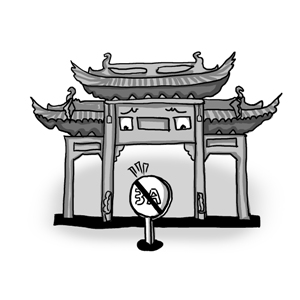Tourist sites need standards

Illustration: Lu Ting/GT
Recently, Shanghai Municipal Tourism Administration released its annual review of 10 A level tourist attractions in Shanghai; nine tourist attractions successfully passed their verification. The only one that was stripped of its rating was Anting Old Street.
In China, there are five ratings for tourist attractions: A (the lowest level), AA, AAA, AAAA, and AAAAA (the highest level). The system was established in 1999 and in 2004 the category of AAAAA was introduced.
The ratings are administrated by the China National Tourism Administration, and the annual review that checks the attractions continue to meet the national standards is conducted by local tourism administrations.
The criteria for rating tourist attractions include the importance of the site, transportation, shopping, business management, security and sanitation. The number of visitors is also a factor. AAAA tourist attractions have to host more than 500,000 travellers a year, while AAA attractions must see at least 300,000 visitors.
According to local media, the reason that Anting's AAA rating was rescinded was because many of its tourism service enterprises have stopped business and few tourists actually visit the street.
Anting Old Street is located in Anting town in Shanghai's northwestern Jiading district. Human settlement dates back to at least the Three Kingdoms period (220-280), when Puti Temple was built, and it gradually became a town. In the Ming Dynasty (1368-1644), Chinese writer Gui Youguang moved to Anting and taught lessons there, helping to put the town on the map.
In 2002, the Anting town government started restoration and improvement of the old street in an attempt to make a 1-kilometer-long cultural tourist site, where visitors could buy Chinese paintings, strange stones and antiques. In February 2010, Anting Old Street was formally classified as a national AAA tourist attraction and the town government continued developments to attract investment.
However things did not turn out as planned. Although Anting was initially able to attract a number of cultural businesses, owners soon found that the street was too far from the city center to attract many tourists. The local Anting town government lured businesses with rent-free policies, but after three years, business owners had to pay rent. Unable to generate much revenue from foot traffic, many of them chose to leave.
There are a number of other old towns in Shanghai, most of which are also a good distance from the city center, like Zhujiajiao, Fengjing and Qibao. However, these tourist sites were developed much earlier than Anting. In China as elsewhere, first impressions are often strongest, so when Shanghainese decide to visit or recommend an ancient town to visitors, they tend to forget about Anting and instead think of Zhujiajiao or Fengjing.
What's more, those old towns have already been integrated into their local environments, and local self-sufficiency has become part of their management conceptions. Anting, on the other hand, is famous as a hub of China's automotive industry. Given its surroundings, the existence of Anting Old Street is like a solitary island which attracts neither tourists nor local residents.
Shanghai Municipal Tourism Administration's decision to strip Anting Old Town of its AAA rating is good news. It demonstrates that the title is not a lifelong guarantee. A tourist attraction has to work hard to maintain itself and keep its title. The annual review and cancellation mechanism is necessary and Anting's failure to pass the test serves as a reminder for all of Shanghai's national-level attractions.
While it's still not the end for Anting, the provisional chill is an opportunity for the local government to consider and explore a more appropriate development path for the town.